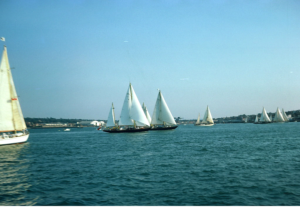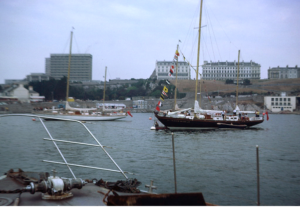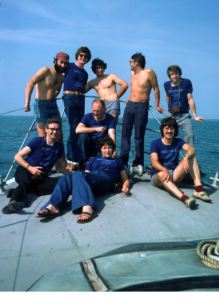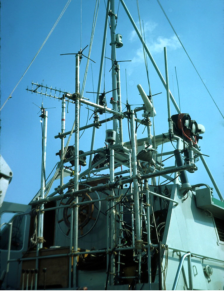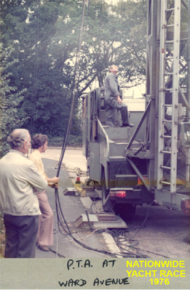Roger Bunce
Anyone remember when “Nationwide” first started? And a youthful Dick Green, on his camera attachment, re-christened it “ATIONWID”, by failing to zoom out far enough! Was that the very first episode?
And Michael Barrett, with his bulging eyes, used to pronounce the word “Nationwide” with a savour and grandeur which is impossible to imitate?
And politicians, and journalists, and anyone who wasn’t Michael Barrett, suddenly started using the phrase, “Up and down the country.” as though they were all desperate to avoid using the word “Nationwide”?
Tony Grant
It was the second day of the programme, crew 9, and Paul Kay who fell about laughing and formally christened it the ‘ationwid’ show, although I hadn’t remembered who’d been on THE camera at the time.
Dudley Darby
Yes, it had been lined up with orbiting on (it was on an EMI 4½” IO on that first one, later replaced with a vidicon). The caption had sat there all day, and with seconds to go a passing engineer switched orbit off.
On one of the final dry runs two of the Sports people popped in to watch, Brian Venner and Bryan Cowgill I think. After a somewhat shambolic set of opts the quite large production committee were congratulating themselves on not falling “off air” with such a complicated show when a loudish voice from the back declared “We do it every Saturday – properly.”
Dave Mundy
.. and [remember] how Michael Barrett somehow got around the BBC directive that family members couldn’t work in the same department (because you would have to write their annual reports!) – I don’t know if he and Sue Cook were married, but questions were asked! I remember it all very well!
Including getting the ‘Nationwide’ sound ‘coffin on wheels’ from stores every Monday and returning it, perfectly packed by Dave Hawthorn, every Friday evening. Poor old Dave must have had a OCD as he always unpacked it and re-did it to his own satisfaction, he ended up as tele-cine organiser after a medical assessment, lived alone on Selsey Bill, and travelled to work by motorbike! He was SA1 on Crew 1 when I arrived from Birmingham radio and I was surprised to find that he, and Dave Ball his SA2, both came from Nottingham, within a few miles of myself, as did Steve Locking and Harry Saunders! Up the Robin Hoods!
Colin Hassell
I think you have the wrong lady.
It was Dilys Morgan that Michael was married to.
Sue Cook was a presenter on the show when I worked on it, which was after Michael had left, I believe.
Bill Jenkin
Sue Cook at about that time was married to John Williams, the virtuoso classical guitarist.
I remember she was interviewing Chuck Berry on the show and they were talking about his guitar. He asked Sue if she played guitar. “No, but my husband does a little” she replied.
Alec Bray
My memory of “Nationwide” was the pig of an axial front projection system mounted on the pan head of Michael Barrett’s camera. The projector, if I recall correctly, had a 35 mm slide cassette system, clunky enough in itself, and combined with the then mechanical Autocue (chain driven and with no feedback to the Autocue control meant that each camera’s script could drift) made that camera just about impossible to operate (“Do you really want me to pan?…”).
PS if I recall correctly, “Panorama” used Teleprompt, a much smaller assembly and which used some synching signals back from the remote to the control. Amazing, eh, mechanical prompters. Sports had their own home grown miniature affair with a magnifying glass on front and was controlled by the presenter with a push button I believe, guess you guys will know more!
Alan Taylor
“Nationwide” is probably more famous for its numerous cock ups than for anything else. I was privileged to be involved in one of the most epic television cock ups – even by “Nationwide” standards. If I were a stand up comedian, I could doubtless do a twenty minute routine solely about the “Nationwide” Yacht Race, but will only bore you with a small snippet of it.
In 1976 “Nationwide” decided to have a race with big yachts ( about 70 ft or so ). It would start at the Royal Yacht Squadron at Cowes on the Isle of Wight and the finish was to be at Plymouth, three days later. When we arrived at Cowes (by hovercraft of course), the wind was almost non existent, it was amazingly calm. Bob Marsland was directing and was asked what the contingency plans were if the calm winds persisted. He responded by dismissing such concerns, explaining that it was fortunate that the calm weather was already with us because it’s never calm for more than a few hours, so by six o’clock tonight, the wind should have picked up nicely.
As the day went on, such breeze as there was completely vanished. Beaufort Scale 0 is defined as “Wind rises vertically”. Looking out from Cowes toward Southampton in the late afternoon, we could see a tall industrial chimney. The smoke was indeed rising vertically to a great height, precisely in line with the chimney and then spreading out in a disk shaped layer somewhere near the stratosphere, looking like a colossal drawing pin. I’ve never seen such a spectacular manifestation of calm weather before or since. The boats could scarcely move, but the race was scheduled to start during the six o’clock “Nationwide” transmission after an entire week of build-ups, so it would most definitely go ahead as planned.
The race was going to be started by firing a series of guns at intervals. The Royal Yacht Squadron has a number of rather splendid small cannons which are fired electrically. It’s important that each gun is fired at the correct time, so if one fails to fire, they have a standby gun with a mechanical trigger operated by a rope. Broadcasting people will doubtless approve of having proper back ups like this, so with such attention to detail, what could possibly go wrong? (Clue – “Nationwide”)
The method of starting the race is that a gun is fired ten minutes prior to the start, then another at minus five and the actual start is signalled by a gun together with a flag being unfurled simultaneously. The tactical challenge for the skippers is to take their cues from the first two guns, anticipate the staring gun and cross the start line at maximum speed as soon as possible after the start gun. If you cross prematurely you must perform a 360 degree turn and recross the line. Obviously in the absence of wind, the start was not likely to be the much anticipated TV spectacle as the boats could scarcely move.
In those days I was assisting and Ian Leiper was the sound supervisor. I was chatting to the guy responsible for the guns and asked him how loud they were. He very obligingly offered to “fire one for level”. Ian was delighted to accept the offer, knobs were twiddled and the gun was duly fired. However nobody thought to warn the skippers and they assumed it was the ten minute gun, even though it was about ten minutes too early. They all had been issued with BBC walkie talkies and all started calling in at once, which meant that none of the messages could get through. Eventually it was possible to explain to them that the gun they heard was not the minus ten gun and the next one fired would be the minus ten and sure enough it was fired at the appropriate time. The boats started to manoeuvre at a glacial pace in anticipation of the minus five gun and then the actual start.
It was now time to hoist a balled-up Union flag, in readiness to be broken to mark the start. It was run up the flagpole, but the rope used to break the flag couldn’t follow its usual route to the starter because the roof of the Royal Yacht Squadron had acquired scaffolding camera platforms, making a direct route impossible. The flag rigger had a long length of rope in his hand and was unsuccessfully trying to get it through the open window. A very helpful floor manager (whose name has been omitted out of kindness) noticed his predicament and obligingly leaned out of the window so that he could catch the rope if it were thrown towards him. The rope was thrown, but a little bit short, so the FM lunged to catch it and did a brilliant catch.
At some point in every story like this, the word “unfortunately” tends to be used so I won’t make you wait any longer. Unfortunately … in his efforts to lunge for the flag-breaking rope, he tripped over the rope which triggered the mechanically fired gun, causing it to fire. The bang from that gun caused him to jump back in shock. Unfortunately (yes that word again), he was holding tight onto the flag rope and inadvertently caused the flag to break open before drooping lifelessly from the top of the flagpole.
Once again all the skipper’s walkie talkies simultaneously burst into life and it was initially impossible for any messages to get through in either direction. Eventually the skippers were informed that the last gun and flag were accidental and the minus five gun would be fired in a few moments. The five minute gun duly went off as planned. The starting gun and flag then happened without incident. Unfortunately the yachts were also sitting in the water without incident as they were still becalmed.
One yacht had drifted over the start line prematurely and would need to do a 360, which took about twenty minutes to complete. The first boat to legitimately cross the start line managed to crawl over it with others following sedately. By the time we had de-rigged and were hovering back to the mainland, the yachts were still visible on the horizon.
Bill Jenkin
I have to say Alan that I think that is the best example of a really good cock up that I think I have ever read about and splendidly recounted.
Mike Jordan
You mean this “Nationwide” Yacht Race?
Nice healthy crew.
We rigged a 100ft mast on Isle of Wight to receive signals only to be told didn’t have permission to park it in the road or abstract power from nearby lamp post with cable across the footpath!
Made it to Plymouth though.
Alan Taylor
Yes, that was the one. Lovely pics, I’m just intrigued how anybody was supposed to steer the boat with all that scaffolding over the wheel?
I assumed that sneakily pinching a bit of power from a convenient lamp post was a technique employed by those cowboys over on the BBC News OB trucks and not something that the law abiding gentlemen at Kendal Avenue did.
Ian Leiper and I enjoyed a leisurely drive from Cowes to Plymouth, taking in the Seaton tramway and the Exeter maritime museum as we went. We had to start early and drive like maniacs to get the planned museum visits in and still reach Plymouth in time for the rig. Afterwards on the way home, we visited the Fleet Air Arm museum and I took Ian to my favourite place for a cream tea in a thatched cottage hidden away in a village near Mere. Life on the road was sometimes rather pleasant.
For those fortunate enough to have known Ian in real life, I’m sure that you would agree that he was very much a character and had something of a rough and ready look to him, together with a down to earth manner of talking. When he called at my house to pick me up for the journey, my two year old son was fascinated by Ian and asked my wife “So what sort of man is that then?”.
Pat Heigham
Ah! The splendid Ian Leiper.
In the 1960s TC1 Sound gallery only had one twin turntable unit. Ian, on grams, continually complained to the sound office that there should be 4 turntables, as per the other TVC studios. One day he brought in an Edison wax cylinder player, on which he’d mounted a stereo cartridge, for vertical compliance to track the ‘hill and dale’ grooves. The studio maintenance TAs had soldered the ball from a biro to the shank of the cartridge and plugged it into the sound desk. Sam Hutchings came round on his daily visit and spotted the device.
“Why’s that there?”
“Because you won’t give me another two turntables!” Ian retorted!
And on STO Course 21:
This finished up near Christmas 1966. Instead of the obligatory programme, mounted for the benefit of the tutors to see what we had learned! we rebelled and put on a pantomime in the dance hall of the Evesham Club.
Two very talented guys wrote a script, loosely based on Dick Whittington and his Cat. Dick was depicted as a bit of an ingenue, and the cat was his sophisticated guide to London. Eric Wallis was the street-wise cat, in evening dress, ears poking out of a top hat, and my Mum made him a black velvet tail which he carried nonchalantly over his arm, who guided a rather dim Dick Into the vagaries of a big city.
Ian Leiper played a Sultan, in baggy pantaloons!
All the old traditional gags were reconstituted, with one involving cries of ‘beware the cockroaches under your chairs’, after slinging handfuls of in-shell peanuts around the floor.
Alan Taylor
Similar to the cockroaches under the seats, Michael Hurll always liked to do the warm up for “Seaside Special” himself. The show was recorded in a circus big top and part of his warm up involved explaining how a circus tent is erected. Essentially the canvas is laid out on the ground in the correct place, the the four big ‘king poles’ are placed over their respective holes in the canvas, the king poles are raised Into position and the canvas is hoisted up. Then the queen poles and jack poles are used to support the outer parts of the big top.
Michael would explain all this while pointing to the appropriate components and it was all factually correct. He explained that although it’s normally done that way, when they erected the tent at this location, there was an industrial dispute and the canvas was left on the ground overnight before being raised. He went on to explain how a typical square yard of grass is home to about two dozen spiders and the canvas covered a thousand square feet. When the sun rose in the morning, those spiders were attracted to the warmth of the canvas and were inadvertently hoisted up into the air where some of them might still remain.
He went on to explain that spiders have a very acute sense of hearing and are distressed by loud noises. It would be unfortunate if any spiders dropped down during the show, so just in case any are still up there, it would be prudent to give an immense round of applause to shake them out.
As the audience cheered, the crew were stood behind the audience seating and threw handfuls of dried rice into the air, freaking out many of the audience when it landed on their hair.
Dave Le Breton
I forwarded Alan’s highly entertaining story to the group of ex-Tel OB people who, in normal times, I meet with at the Black Horse on a Thursday lunchtime. I received one “I was there too” from Phil Thomas, who says he was on one of the boats with a Bosch Fernseh KCN. The event was particularly memorable as he needed medical attention because someone shut a hatch on his head. Toward the end of his life, Ian Leiper joined us at the Black Horse, arriving in his Triumph Herald, complete with a rather noisy dog. He was certainly a character. I am the outsider in this group, having been a member of P&ID (and whatever it was called later), but around 1970 and the Type 2 CMCRs, I spent a great deal of time at Kendal Avenue testing and commissioning all 30 EMI 2001s.


